Messier Observing Program Coordinator:Scott Kranz |
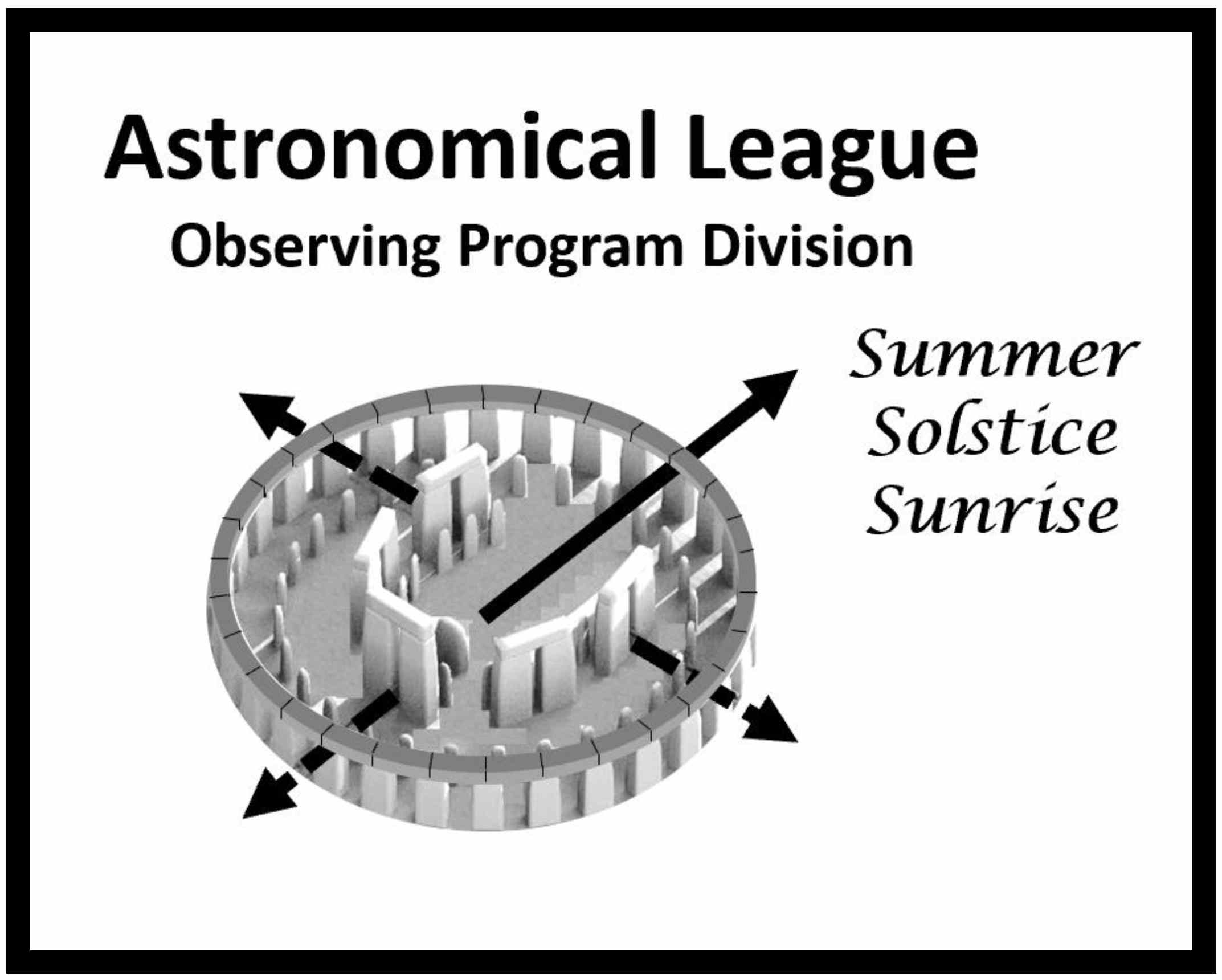 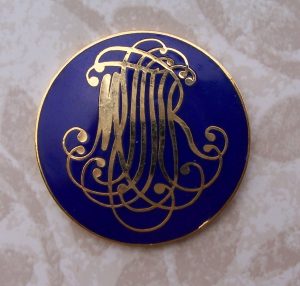 |
IntroductionAlmost every amateur astronomer begins to be aware of the Messier Catalog as soon as he or she opens their first book. The novice is sure to find some spectacular object pictured and designated by its “Messier Number” with the universal abbreviation “M”. Of the myriads of star clusters and nebulae scattered over the sky only about 100 (perhaps 110 at most) can claim membership to this celebrated list. However, this happens to include most, but not quite all, of the finest of these objects observable from mid-northern latitudes. There is nothing in the catalog that the owner of so humble an instrument as a three-inch reflector cannot reach under good observing conditions. Many of the objects can be seen with binoculars and some with the naked eye. Thus, the Messier Catalog is a happy hunting ground for any amateur with a taste for deep-sky objects. Even an extremely brief review of the history of Messier’s Catalog will explain why it contains so many bright and easy clusters and nebulae. |
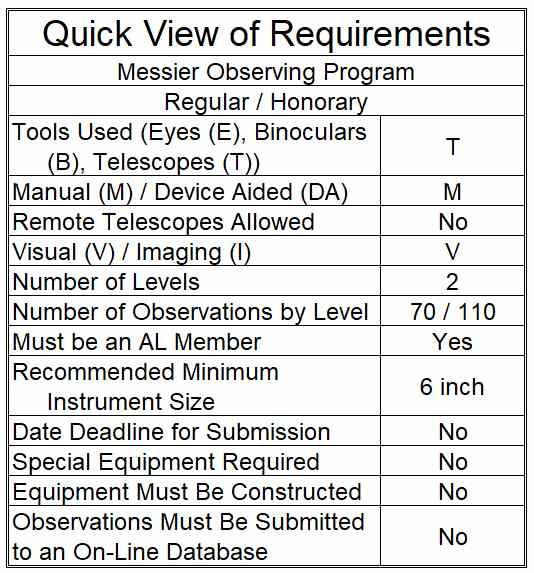 |
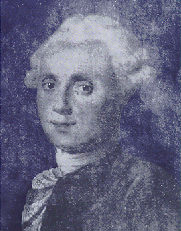 Background Information
Background Information
Charles Messier (1730-1817) was a French astronomer who developed an intense interest in comet hunting. While he had other achievements to his credit, this was his chief occupation during his long observing career. In this, he was so successful that he probably observed half of the comets known in his time. He discovered about twenty. It was to keep track of the star clusters and nebulae which might have otherwise confused him by their comet-like appearance, that he began to catalog and describe them. In commenting on his catalog in later years, he frankly stated that he had compiled it in order to aid other comet hunters. There is a slight touch of irony in the fact that Messier’s chief claim to immortality grew out of his efforts to rid himself of a nuisance to what, he felt, was his important life’s work. As might be expected, Messier’s telescopes were all modest instruments, none of them exceeding the capacity of telescopes amateurs can expect to own today.
Messier did not discover all the objects in his catalog and he never made any such claim. Many of the objects were called to his attention by his contemporaries, notably Pierre Méchain and the fact was always carefully noted. The catalog was published in several stages as additions were made to it, the first 45 entries being printed in 1771. In its classic form, it contained 103 entries. Studies of Messier’s papers and correspondence (Dr. Helen Sawyer Hogg and Dr. Owen Gingerich) suggest that another four to six objects should be added to bring the total to 110.
The prospective observer should be warned that if he follows the older editions of the catalog or many of the older charts, he or she may find nothing in the position indicated. More recent editions have corrected these errors but there are a few entries about which there is some doubt.
Requirements and RulesThis certification is available to members of the Astronomical League, either through their local astronomical society or as members at large. If you are not a member and would like to become one, check with your local astronomical society, search for a local society on the Astronomical League Website, or join as a Member-At-Large in the AL Store. The Astronomical League offers special recognition in the form of a Messier Observing Program certificate for those who have observed most or all of the Messier objects. There are two levels of this certification: The Silver Level for observing 70 objects (certificate only) and the Gold Level (formerly the Honorary Level) for observing all 110 objects (certificate and pin). To obtain certification you must observe these rules: |
>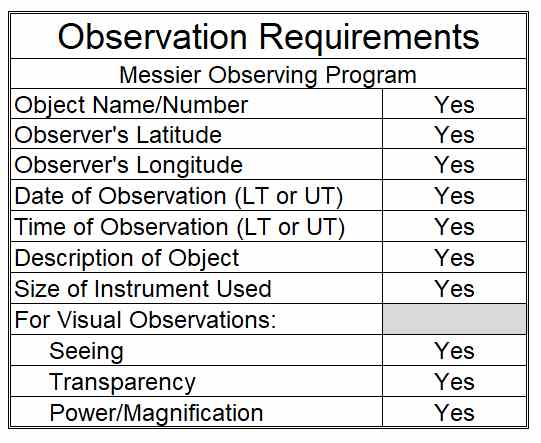 |
Rule 1 (Silver Level):
Visually observe 70 Messier objects and keep a record of your observations. Your notes must include:
a. Date and Time of observations (local time or UT)
b. Latitude and Longitude of observations
c. Seeing and Transparency
d. The Aperture size of Telescope
e. Power Used
f. A Description of the Messier object as it appears in the eyepiece.
Rule 2:
Have your observing log examined by an officer of your Astronomical Society or a suitably qualified second party. If you are not a member of a society you may send a copy of your logs to the Messier Observing Program Coordinator directly. After reviewing and approving your observations this party should forward a letter or email to the effect that you have made the necessary number of observations.
Be sure to include your name, mailing address, email address, phone number, and society affiliation. This letter should be addressed to the Messier Observing Program Coordinator.
Only non-society members need to actually mail their observing log to the Messier Observing Program Coordinator. The letter should specify the address to which the certification should be mailed. The certificate will be suitable for framing.
Rule 3 (Gold Level):
To complete the Messier Observing Program and to receive the Gold Level certification, when you have observed the balance (all 110) of the Messier Objects, your logbook should be examined again and a letter or email forwarded to the Messier Observing Program Coordinator again, indicating that you have completed the observations of the Messier Catalog. You will receive a pin and a Gold Level certificate signed by the current President of the Astronomical League. Be sure to indicate the return address.
Note:
Since the purpose of the Messier Observing Program is to familiarize the observer with the nature and location of the objects in the sky, the use of an automated telescope which finds the objects without effort on the part of the observer is not acceptable. “Automated telescope” also includes the use of digital setting circles where a read-out shows the user directions to follow to locate an object. This also includes the unacceptable use of smartphones that use apps to locate objects in the night sky. The use of the setting circles found on the axis of the telescope should also be avoided. In short, only finder scopes, Telrads, or Telrad-like devices are acceptable.
The reason……?
The purpose of the “no Go-To” rule is so that you learn the sky and learn how to associate a map with the real sky. Learn how to get from here to there without the electronics or the scales. Learn to locate objects without the electronic interface. The knowledge of being able to perform this will always be a benefit in the future.
Also “Messier Marathon” sessions where all the objects are found in one occasion are to be discouraged. An observer cannot truly observe objects properly in that limited amount of time. Take your time, enjoy yourself, and REALLY see the objects as they were meant to be seen.
Rule 4:
This program is meant to be completed using a telescope where multiple magnifications (including a higher power) and filters (if available) can be used. Please do not re-use observations from the Binocular Messier Program towards this observing program.
Submitting for CertificationMessier Observing Program Coordinator:Scott Kranz |
 |
Upon verification of your submission and of your active membership in the Astronomical League, your recognition (certificate, pin, etc.) will be sent to you or to the awards coordinator for your society, as you specified. Your name will also appear in an upcoming issue of the Reflector magazine and in the Astronomical League’s online database. Congratulations. Good luck with your next observing challenge.
Notes:
Looking for more Information and Opportunities?
- The Astronomical League Web Store has a great manual available with information for this Observing Program. It is available here.



